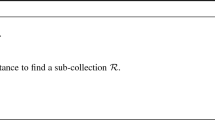Abstract
This paper is concerned with finding two solutions of a set covering problem that have a minimum number of variables in common. We show that this problem is NP-complete, even in the case where we are only interested in completely disjoint solutions. We describe three heuristic methods based on the standard greedy algorithm for set covering problems. Two of these algorithms find the solutions sequentially, while the third finds them simultaneously. A local search method for reducing the overlap of the two given solutions is then described. This method involves the solution of a reduced set covering problem. Finally, extensive computational tests are given demonstrating the nature of these algorithms. These tests are carried out both on randomly generated problems and on problems found in the literature.
Similar content being viewed by others
References
Balas, E. and A. Ho. (1980). “Set Covering Algorithms Using Cutting Planes, Heuristics, and Subgradient Optimization: A Computational Study.” Math. Programming Study 12, 37–60.
Bard, J.F. and T.A. Feo. (1987). “Minimizing the Acquisition Cost of Flexible Manufacturing Equipment.” Technical Report, Operations Research Group, Department of Mechanical Engineering, The University of Texas at Austin, Austin, TX 78712.
Bard, J.F. and T.A. Feo. (1989). “Operations Sequencing in Discrete Parts Manufacturing.” Management Science 35, 249–255.
Beasley, J.E. (1987). “An Algorithm for Set Covering Problem.” European Journal of Operational Research 31, 85–93.
Beasley, J.E. (1990). “OR-Library: Distributing Test Problems By Electronic Mail.” J. Oper. Res. Soc., 41 1069–1072. See also WWW site: http://mgcmga.ma.ic.ac.uk/info.html.
Beasley, J.E. and P.C. Chu. (1996). “A Genetic Algorithm for the Set Covering Problem.” European Journal of Operational Research 94, 392–404.
Brass, P., H. Harborth, and H. Nienborg. (1995). “On the Maximum Number of Edges in a C4-free Subgraph.” J. Graph Theory 19, 17–23.
Chvàtal, V. (1979). “A Greedy Heuristic for the Set Covering Problem.” Mathematics of Operations Research 4, 233–235.
Erdös, P. (1990). “On Some of My Favorite Problems in Graph Theory and Block Designs.” Le Matematische 45, 61–74.
Feo, T.A. and J.F. Bard. (1987). “A Network Approach to Flight Scheduling and Maintenance Base Planning.” Technical Report, Operations Research Group, Department of Mechanical Engineering, The University of Texas at Austin, Austin, TX 78712.
Feo, T.A. and M.G.C. Resende. (1989). “A Probabilistic Heuristic for a Computationally Difficult Set Covering Problem.” Operations Research Letters 8, 67–71.
Feo, T.A. and M.G.C. Resende. (1995). “Greedy Randomized Adaptive Search Procedures.” Journal of Global Optimization 6, 109–133.
Garey, M.R. and D.S. Johnson. (1979). Computers and Intractability: A Guide to the Theory of NP-Completeness. W.H. Freeman and Company New York.
Goldberg, M.K. and H.C. Russell. (1995). “Toward Computing m (4).” Ars Combinatoria 3, 139–148.
Grossman, T. and A. Wool. (1997). “Computational Experience with Approximation Algorithms for the Set Covering Problem.” European Journal of Operational Research 101, 81–92.
Harborth, H. and H. Nienborg. (1994). “Maximum Number of Edges in a Six-cube Without Four-cycles.” Bull. Inst. Combin. Appl. 12, 55–60.
Author information
Authors and Affiliations
Rights and permissions
About this article
Cite this article
Hammer, P.L., Rader, D.J. Maximally Disjoint Solutions of the Set Covering Problem. Journal of Heuristics 7, 131–144 (2001). https://doi.org/10.1023/A:1009687403254
Issue Date:
DOI: https://doi.org/10.1023/A:1009687403254




